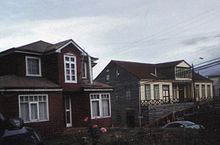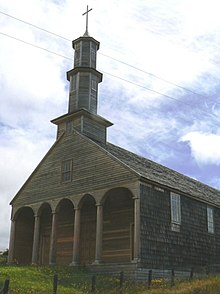Chonchi
Chonchi is a city and municipality ( Comuna ) in Chile on the island of Chiloé in the Región de los Lagos .
location and size
The combined community is located on the east coast of the island of Chiloé and covers an area of 1362.1 km². It consists of the city of Chonchi and the following villages:
population
The 2002 census showed Chonchi a population of 12 572 inhabitants (6453 male and 6119 female sex). Of the inhabitants, 4588 (36.5%) lived in the city of Chonchi itself and 7984 (63.5%) in the ten villages belonging to the municipality. From 1992 to 2002 the population increased by 18.3% (1,945 people).
history
Chonchi was initially a Jesuit mission station in an indigenous Huilliche village with a school in which 150 children were educated in 1755. The city itself was founded in 1767 on the orders of the then governor of the island of Chiloé, Don Guil y Gonzaga, and in 1787 had 315 inhabitants (80 Europeans and 235 Huilliche). With the independence of Chile from Spain in 1818, the importance of the city increased. A census in 1833 showed that Chonchi was the most important place in the south of the island of Chiloé. It was officially declared a parish in 1836. From 1880 there was a significant boom in forestry on Chiloé, from which the city of Chonchi also benefited, and as a result the port was expanded. Its main purpose was to export cypress wood and grain. The first representative, wooden residential buildings of wealthy patrician families, which are still worth seeing today, were built in Calle Centenario, which connected the port with the central main square of the city and the church. Many people lived in wooden stilt houses at the harbor . On June 21, 1886, Manuel Jesús Andrade Bórquez was born in Chonchi, who composed the hymn of Chiloé.
The 1930 census showed a population of 14,546, and from 1953 Chonchi was connected to the next larger town, Castro, by a good road, so a bus connection was established - until then the town had to rely on the ship connection. The devastating earthquake of 1960 also caused considerable damage in Chonchi, including almost all pile dwellings in the lower part of the city. On January 13, 2002, several of the wooden buildings declared national cultural monuments in Irarrazabal Street fell victim to a major fire. Towards the end of the 20th century, a new economic boom began in Chonchi with the rise of salmon farming and the development of tourism in the south of Chile.
Architecture and sights
Chonchi is also called Ciudad de los Tres Pisos in Chiloé , which means "city of three floors": In this comparison, the area at the port with the local Feria Artesanal market corresponds to the ground floor, while the first floor corresponds to the slightly higher part of the city Area of the museum and the second floor corresponds to the area around the town square with the church.
- In Chonchi - in contrast to other comparable cities on the island of Chiloé - there are still numerous wooden residential buildings from the end of the 19th and the beginning of the 20th century, especially in the commercial street Calle Centenario . They remind of the time of the economic boom due to the flourishing forestry. Interesting older residential buildings are also located on the plaza, the central main square of the city, which, in contrast to the other cities of Chiloé, is not square but triangular in Chonchi.
- The main attraction of the city is the church of San Carlos de Borromeo , one of the 16 wooden churches of Chiloé, which were declared a World Heritage Site by UNESCO in November 2000 . The construction of the church began in 1754, interrupted several times and was not completed until 1859. The church was built on a flat stone plinth to protect it from moisture, and the wood used primarily was larch and especially southern beech , which does not rot even in the damp climate of southern Chile. As with the other wooden churches in Chiloé, not a single metal nail was used in the construction, as metal was very scarce on Chiloé. Instead, wooden rivets were used. The church was declared a national treasure in 1971 and extensively renovated for the first time in 1995–1996. The tower collapsed in a storm in 2002 and was rebuilt in 2004-2005, on this occasion a renewed restoration of the church, which consists of three naves and can be reached from the central main square of the city through a portico with five arches.
- In the area of the municipality of Chonchi, another wooden church has been declared a World Heritage Site: San Antonio de Padua in the village of Vilupulli in the north of the municipality on a hill whose name means "snake hill" in the Huilliche language. The church, whose tower is one of the highest on the island, was consecrated on January 16, 1872 and declared a national treasure on July 26, 1971. Like the other wooden churches on the island of Chiloé, it has a three-section gable roof with a tented roof . The church can be reached through a portico with columns and five arches. As with the other wooden churches on Chiloé, each of the three naves has its own door to enter from the portico.
- The Museo de las Tradiciones Chonchinas regional museum is housed in a prestigious residential building on Calle Centenario . The ground floor shows exhibits from the living culture of the upper class from the beginning of the 20th century, while the upper floor and the third floor depict the everyday life of the lower class of the population in Chonchi in the 20th century.
- The cemetery in the west of the city is also worth seeing. Numerous grave sites in the form of small wooden churches made of shingles can be seen on it.
- The fortress Fuerte Tauco was built in 1780 on the Fiordo de Castro bay to secure the shipping route to Castro. However, the complex was never used as a fortress.
Surroundings
The lakes Lago Huillinco, Lago Tarahulín, Lago Natri and Lago Tepuhueico and most of the Chiloé National Park are located in the area of the municipality of Chonchi .
Huillinco is a village on the lake Lago Huillinco with 943 inhabitants (2002), most of whom are Huilliche, in which the cemetery with tombs in the form of small churches made of larch wood is worth seeing.
Cucao is one of the few places on the west coast of the island. It is a village with 424 inhabitants (2000) at the entrance to the Chiloé National Park, in which, among other things, a 700 m long forest nature trail and a small open-air museum are worth seeing.
Transport links
From the provincial capital Castro, 23 km away, Chonchi can be reached via the well-developed national road 5, on which buses run several times a day in both directions. Partly asphalt and partly gravel roads lead into the ten villages belonging to the municipality of Chonchi, which can be used in any weather. In the south of the municipality of Chonchi there is an hourly connection to the island of Lemuy with a car ferry from the small ferry terminal Puerto Huichas . The closest airport is on the mainland in Puerto Montt .
Individual evidence
- ↑ a b Juan Mancilla Pérez: Pueblos de Chiloé , p. 56. Castro 2008
- ↑ a b Juan Mancilla Pérez: Pueblos de Chiloé , p. 57. Castro 2008
- ↑ Jorge Sánchez R .: Chiloé - tradición y cultura , p. 42. Santiago de Chile 2006. ISBN 956-309-024-1
- ↑ Dominique Verhasselt: Chiloé archipielago - el encanto de una isla misteriosa , p. 38. Santiago de Chile undated ISBN 978-956-7136-53-7
- ↑ Dominique Verhasselt: Chiloé archipielago - el encanto de una isla misteriosa , p. 37. Santiago de Chile undated ISBN 978-956-7136-53-7
- ↑ Juan Mancilla Pérez: Pueblos de Chiloé , p. 59. Castro 2008
- ↑ Juan Mancilla Pérez: Pueblos de Chiloé , p. 60. Castro 2008
Web links
- Municipality of Chonchi
- Chonchi , VisitChile.com
- Map , ChiloeWeb.com
Coordinates: 42 ° 37 ′ S , 73 ° 46 ′ W




